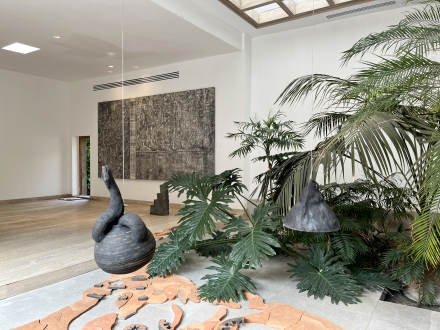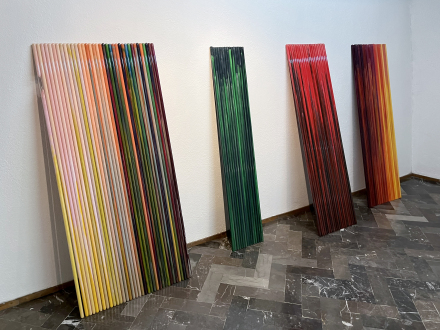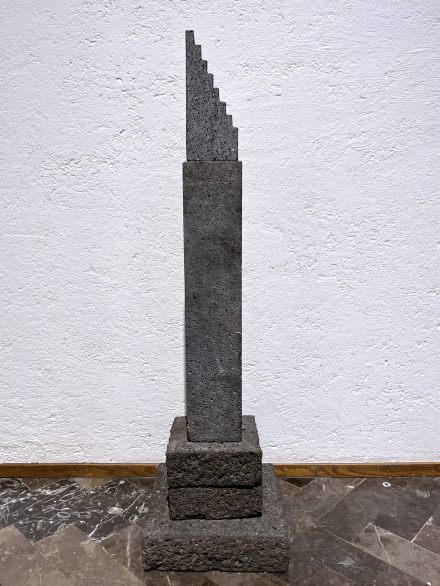
Vivarium (Installation View), via Anfisa Vrubel for Art Observed
Tucked away on a quiet side street in the heart of Mexico City’s San Miguel Chapultepec neighborhood, the new JO-HS Gallery is a stone’s throw away from the frenetic energy of the city, and yet a world apart. Draped by a cascade of ivy, the two-story modernist building that houses the gallery was designed by the architect Carlos Herrera in 1981, and served as his studio and workspace for several decades. It was recently taken over and renovated by Elisabeth Johs, curator and owner of the eponymous gallery. Inspired by the vibrant art and culture scene in Mexico City, Johs set out to create a new type of cultural space that would be a hybrid between a gallery, studio space, and artist residency.

Vivarium (Installation View), via Anfisa Vrubel for Art Observed
The architecture of the gallery is a classic example of the Mexican modernist style, with its organic forms and materials, and abundant light that streams in throughout the day. An expansive floor-to-ceiling window runs the length of a long central hallway, revealing an inner courtyard that landscape artist Carla Hernández turned into a verdant garden. The window frames a lush micro-ecosystem, turning the outdoor space into a natural diorama. Walking through the hallway, the impression is one of being simultaneously inside and outside. This playful spatial ambiguity is what inspired the name of the gallery’s inaugural exhibition Vivarium.

Vivarium (Installation View), via Anfisa Vrubel for Art Observed
According to Johs, a vivarium is an ecosystem and an environment that allows something to survive—contemporary art, in this case. “I wanted to take the gallery space and look at it in the same manner,†Johs said. “What does art need to survive?†For Johs, the art that is ultimately sustained is one that triggers a cultural response. The eleven artists who are featured in this exhibition were asked to reflect on what art needs in order to escape the perpetual cycle of newness that characterizes the contemporary, and to imagine what comes after that. The result is a meditation on art as it relates to time.

Vivarium (Installation View), via Anfisa Vrubel for Art Observed
Working across different mediums such as volcanic stone, clay, glass, large-scale dyed canvases, and photography, the artists in the show represent a distinctly Mexican vernacular. The exhibition opens with a sculpture by Perla Krauze, a figure of the Mexican art-scene who works primarily with volcanic rock to create instances of ‘ascending matter.’ Next to her is a sculpture that resembles a metal origami sundial, made by Carlos Garcia-Noriega, an artist and architect who works with precious metals to create pieces that have an “everlasting aspect to them,†says Johs. In one of the central rooms hang two textile works by the artist duo Celeste, who dye fabrics and sew them together before painting on them. The result is ethereal canvases that feature a soft palate of mauve, gold, and reddish tones fusing into abstract and esoteric shapes that resemble wispy outstretched hands. In another room, a sprawling sculptural work by Tania Ximena stretches out on the floor. Her topographical clay sculptures are based on the mountain landscapes that she visits and traces, recreating them later in her studio. The work is flanked by palms and monsteras—another instance of nature seeping into the gallery space.

Vivarium (Installation View), via Anfisa Vrubel for Art Observed
Vivarium runs through December 4th , 2021. The next exhibition at JO-HS, titled Girasol, is scheduled to open on December 9th and will feature a selection of paintings by artists working in and outside of Mexico.
– A. Vrubel
Read more:
Vivarium [Exhibition Site]



